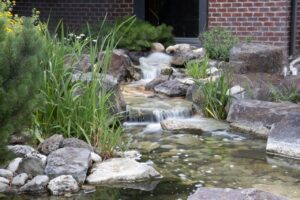What is green landscaping? The tongue-in-cheek answer is that it’s about using one color in the garden. However, it isn’t about color — it’s about eco landscaping.
Green landscaping means working with nature to create a lush, vibrant, low-maintenance garden. An environmentally friendly landscape centers on natural feeding and watering methods to boost indigenous plants.
How Green Landscaping Works
Green landscaping design means centering nature. That means understanding:
- The climatic conditions in your area
- Which native plants thrive
- The soil conditions
- Natural methods to retain moisture and nourish the soil
Green Landscaping Ideas
Function
What function will the area serve? Do you want a tidy lawn, privacy, a scent garden, or is the project focused on a new lawn installation? If you define the function of each area, it’s easier to choose green landscaping techniques to employ.
Repetition
Symmetry and repetitive elements unify the design as a whole. In environmentally friendly landscaping, you can up the ante by using repetition to create swathes of color.
Shades
Green landscapers also change up the shade of the leaves. Green comes in different shades to create tonal depth in your garden.
Textures
Look for plants with different leaves or surfaces. Juxtapose soft, fuzzy lamb’s ear leaves against slick, dark juniper leaves. Consider mixing monstera leaves with delicate garden orchids.
Shapes and Sizes
Play up the symmetry you created earlier by adding bushes of different shapes and sizes. The interplay of color, texture, and shape is what makes green landscaping interesting.
5 Tips for a Lush and Eco-friendly Landscape
Go Native
Choosing native plants is a primary tenet of eco-friendly landscaping. Such plants are capable of thriving in your local environment. They require less maintenance than imports and are less likely to get sick.
They also provide a valuable resource for local fauna and insects.
Use Mulch
Organic mulch chokes out weeds, maintains the moisture levels in the soil, and keeps the plant’s roots cooler. As the mulch decays, it releases nutrients, making it one of the best green landscaping additions.
Amend the Soil
Healthy soil makes for healthy plants. Keep the nutrient level up by composting garden cuttings, wood shavings, eggshells, fruit scraps, and newspaper or cardboard. These materials will break down over a few months to form nutrient-rich compost.
Be Water-Wise
Reduce your water requirements by planting water-wise plants, harvesting rainwater, and using mulch. Water during the cooler parts of the day to reduce evaporation.
Utilize Hardscapes
Terraces and retaining wall contractors can create areas for planting to extend the usefulness of slopes in the garden.
Advantages of Green Landscaping
Provide Cooler Temperatures
Mulch keeps the surface temperature of the soil cooler.
Good for the Air and Water
Natural composting methods reduce the number of artificial chemicals in your soil. The natural loam filters out impurities in the rainwater, and your plants receive cleaner water. When they respire, they breathe out purer air.
Outdoor Living Areas Improve Quality of Life
Being out in nature is the ideal way to relax and play. You can entertain, have a quiet romantic dinner, or spend time solo.
Retaining Walls Prevent Erosion
Retaining walls propping up terraces of plants form a strong defense against erosion.
Is Green Landscaping the Answer for You?
Call New Life Rockeries at 206-489-3734 or reach out through our website for your green landscaping contractor consultation.



